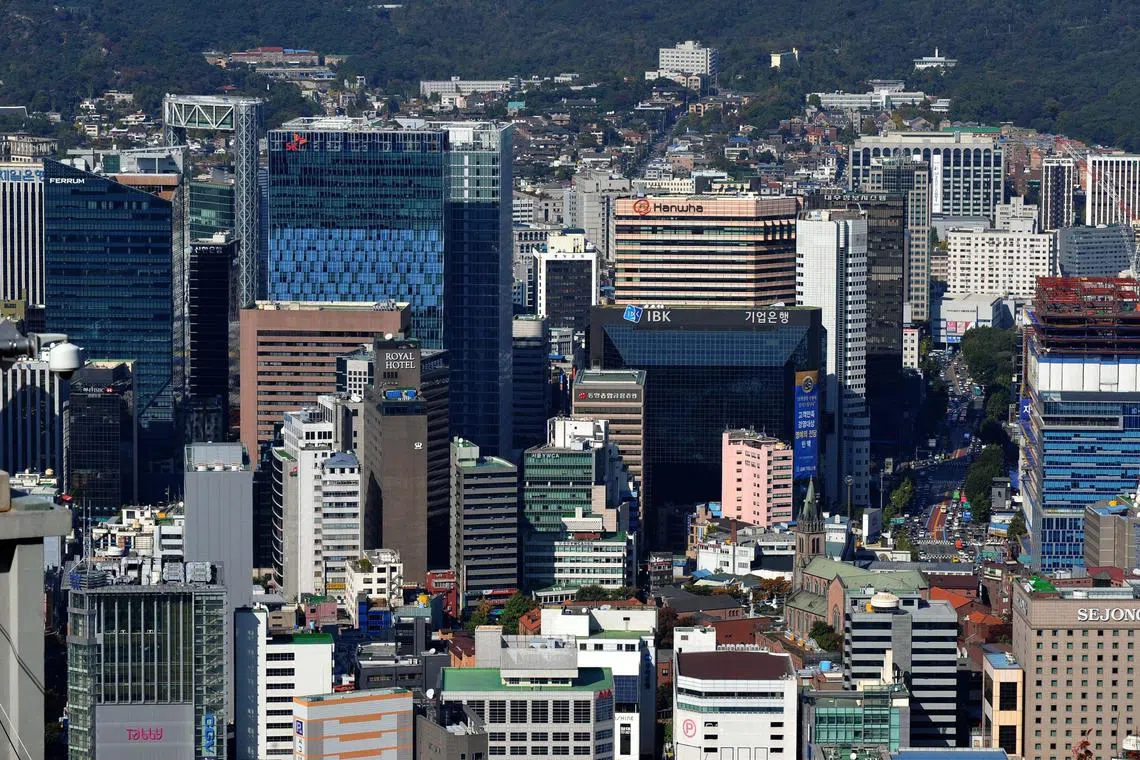Seoul office market has occupancy of over 98% as demand elsewhere craters
Sign up now: Get ST's newsletters delivered to your inbox

More than 98 per cent of grade A offices in Seoul are occupied, with rents surging 15 per cent from 2022.
PHOTO: BLOOMBERG
Follow topic:
HONG KONG – From London to New York, nobody wants to be a commercial landlord these days. But in the South Korean capital, owners of office towers are living the boom life.
Seoul’s office market is every landlord’s dream: More than 98 per cent of grade A offices are occupied, with rents surging 15 per cent from 2022. The competition for space is so fierce that when there was a floor available in Parnas Tower at the heart of the prestigious Gangnam district, a dozen domestic and international companies turned up in a tender to outbid one another.
“Particularly for the tenants looking for large spaces, they really have nowhere else to go,” said Cushman & Wakefield Korea head of leasing Y.J. Choi. “So they’re just taking it, even if it means a 30 per cent or 40 per cent rise in price.”
Such a scenario is unimaginable for landlords in the United States, where offices are seeing tenants cut space or move out as employees become reluctant to badge in.
Property owners are struggling to stay afloat with higher interest rates squeezing margins even more. Office prices in the US are due for a crash, and the commercial real estate market faces at least nine more months of declines, according to a recent survey conducted by Bloomberg.
And in an ironic twist, South Korean investors have been among the most badly burnt by the global market’s collapse. Pension funds, insurance companies and asset managers ploughed billions into overseas properties just before the Covid-19 pandemic drove down their value, raising the risk of a credit crunch.
In South Korea, the market is thriving because of a unique mix of supply and demand factors, cultural preferences and economic resilience. The capital had a vacancy rate of just 1.7 per cent in the third quarter, compared with an average of 19 per cent in Asia, according to data from CBRE Group.
Offices have been in short supply in Seoul since 2021, with just half of what has historically been available, according to CBRE head of research for Korea Claire Choi. She expects the shortage will last until 2025, when new projects now under construction will come online, and rents to grow year on year by about 15 per cent in 2023.
Redevelopment restrictions imposed by the government a few years ago and disruptions to development plans by the pandemic have contributed to the lack of supply, according to CBRE.
Meanwhile, the demand for offices is steady, thanks to the robust domestic economy. South Korea’s economy recorded growth during most of the pandemic due to strong overseas markets for its products including microchips and cars. Local companies make up about 80 per cent of tenants in the commercial market, so even if foreign companies downsize, the overall need for space remains.
It is a cultural thing, said one of the analysts. The work-from-home trend that has been emptying office floors in many Western economies does not apply to Seoul, or to most of Asia. If people are told to come back to the office, they will come back.
Mr Calvin Chou, co-chief investment officer and head of Invesco Real Estate in Asia-Pacific, said: “Korea is probably the strongest performing office market in the world for the last two years.”
Even though borrowing costs are generally higher than typical rental yields of 4 per cent – a main reason why office purchases are rare in many parts of the world now – Invesco still received competitive offers in a recent sale of a 17-storey office tower in Gangnam.
The US company eventually sold the asset for US$385 million (S$519 million), almost double the original purchase price in 2017.
“When my colleagues or peers in the US and Europe saw the headline, they were surprised,” Mr Chou said of the price. “It just goes to show the Asian market operates very differently.” It also reflects that investors expect rental yield and income in South Korea to grow over time, he added. BLOOMBERG

